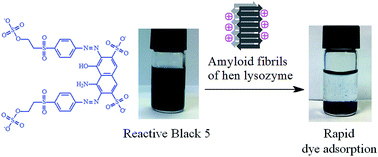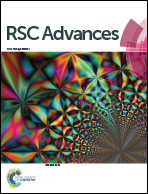Amyloid fibrils as rapid and efficient nano-biosorbents for removal of dye pollutants†
Abstract
This study demonstrates the promising role of amyloid fibrils as rapid and efficient nano-biosorbents for removal of dye pollutants in water. Amyloid fibrils of hen lysozyme, which are highly ordered protein nanofibers, can be prepared easily in one step under green and mild aqueous conditions. Results of zeta-potential and fluorescence measurements indicate that lysozyme nanofibers bear positive/negative charges and hydrophobic regions along their fibrillar structures. These special structural properties enable lysozyme nanofibers to adsorb the anionic dyes Reactive Black 5 and Acid Blue 29 and the cationic dye Victoria Blue B rapidly and efficiently, presumably through multiple intermolecular interactions (e.g. electrostatic attraction and hydrophobic interaction); the adsorption equilibrium for these dyes can be reached within 15 min, and a dye removal efficiency of over 60% can be achieved in industrial wastewater. Lysozyme nanofibers are also compatible with magnetite nanoparticles to form magnetic nanofibers, which can provide rapid and convenient dye removals through the application of an external magnetic field and maintain high dye removal efficiency (92–99%) after undergoing 20 cycles of desorption.

- This article is part of the themed collection: Towards understanding and treating Alzheimer’s disease

 Please wait while we load your content...
Please wait while we load your content...